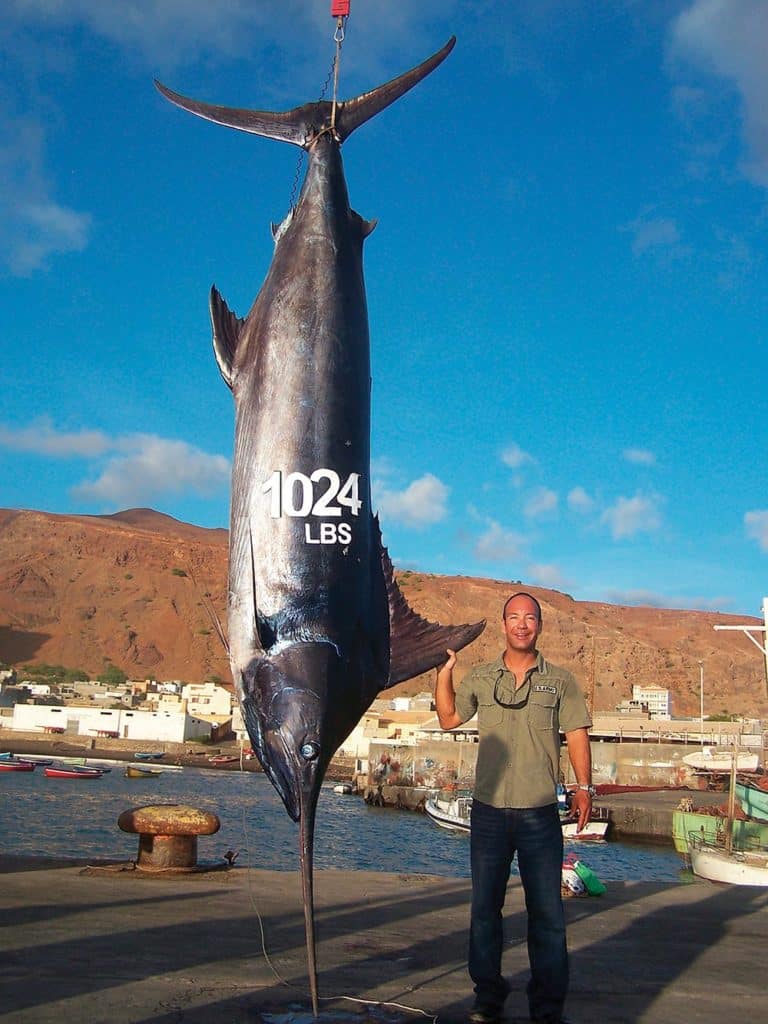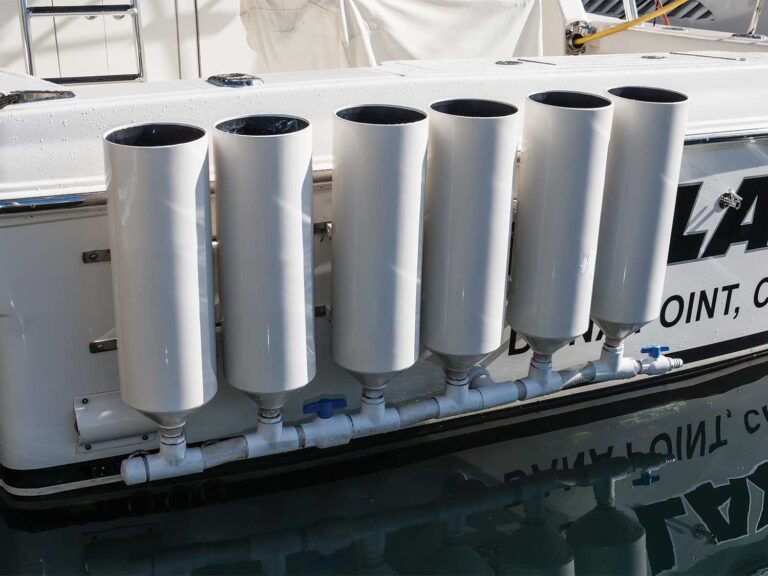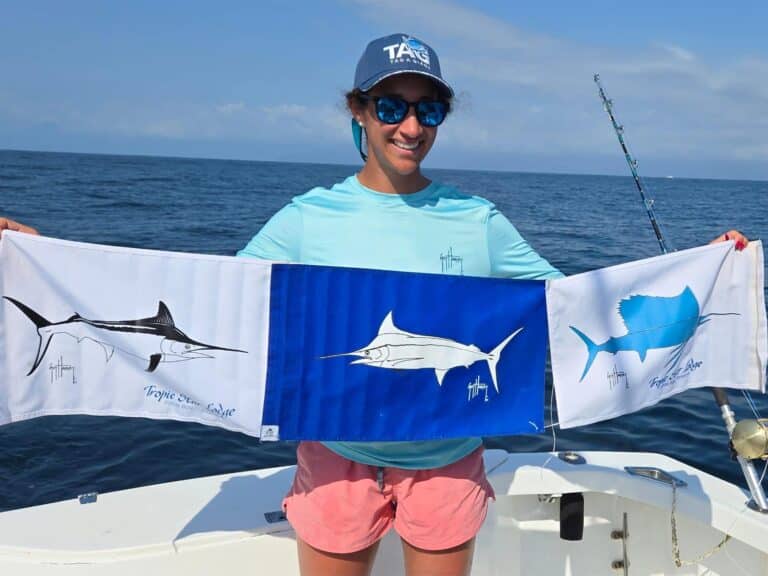
An addiction that started in the late 1990s with an invitation to fish in Ghana, West Africa, soon had German-born Heiko Steinmetz traveling the world in search of his own giant blue marlin. To fuel his obsession, Steinmetz moved his 29-foot Parker, Black Marlin, to the idyllic archipelago of Cape Verde to begin the exhausting and emotional learning curve of chasing big blues. The drive for success comes not from doing one thing occasionally, but from doing one thing consistently. This is the story of one man’s 10-year venture to succeed.
Grander No. 1: 1,012 pounds; September 1, 2009
August’s heavy rains had saturated the ocean with dirty, green water. For two weeks, not a single marlin came into the spread, and this was just another hopeless day. But, this was the day I learned one of my first lessons: The big one always comes when you least expect it.
I had been teaching a young man named Dika Cosme to run my boat, and we weren’t 10 minutes out of port when the marlin appeared. The strike was intense and solid. Its first run almost spooled me, so Cosme started to run the fish down in forward at 20 knots. For 20 minutes I constantly wound up the slack. Then, the marlin just sat there.
After another 15 minutes and 65 pounds of heat, I lifted the heavy fish within reach. As soon as the mate had the leader, I left the chair and quickly sank the flying gaff. We brought it aboard, hoping the 21-inch tail girth meant the fish would break the 1,000-pound mark. On the scale, the fish weighed 1,012 pounds — bigger than the 350 blues I had caught previously. I was so happy to have finally caught my grander, and promptly donated it to the local hospital.
Grander No. 2: 1,024 pounds; August 31, 2010
It had been so rough in the weeks prior that it was impossible to fish my preferred spots. A calm day finally arrived, and I headed out with a friend, Dutch Capt. Faust van Meel. We fished all day, circling my spots without a single knockdown. I was thinking of wrapping it up, then I saw the marlin: a huge black shadow, just outside the pattern by 50 yards. “Marlin! Marlin!” van Meel screamed at the top of his lungs, as my Black Bart Abaco Prowler took a hit and the line started screaming off the Shimano 130W.

I immediately knew this was a big one. I got settled in the chair and noticed 600 yards had come off the spool in an instant, and I was still losing line even though van Meel was backing down. After splashing 300 yards off the side, the fish went straight down, taking more than 500 yards of mono with it. We had to change the angle and turn the marlin’s head, but it didn’t like that at all. It swam straight up and started jumping wildly, so I could see just how fat it was.
After over an hour, the flying gaff went in, and the fish immediately shook it out. I jumped out of the chair and quickly set another flyer, and my mate followed with a second. The marlin was ours.
We donated the 1,024-pound fish — with an 81-inch girth, 10 inches less than my first — to the Red Cross.
Grander No. 3: 1,234 pounds; August 6, 2016
The ocean was like a mirror that day. After eight hours without a bite, my green-and-yellow Black Bart Grander Candy got bit. Very little line had come off the reel, then the engine stalled. No big deal, I thought. I should be able to dead-boat a small marlin.
After a few minutes, we noticed the boat was being pulled backward and the line had slowly started to come off the spool. We got the engine running and were off to catch what I thought was a small fish. Each time Cosme was within leader reach, the marlin would pull off another 100 yards, but never more than that.
Two hours later, I realized we were 7 miles from where we hooked up, so I started to turn up the heat on something we still hadn’t seen. Thinking this could be another massive fish, I suddenly realized I was going to need every bit of my two decades of angling experience to land it.
At 75 pounds of drag, fighting the fish inch by inch in low gear, the marlin broke the surface just as the mate grabbed the leader. “Monster!” I yelled, as it tried to escape under the boat, but we held onto the fish just long enough to sink the first gaff.
I dedicated that fish to my newborn son, whom I was holding in my arms as the scales hit 1,234 pounds — the 13th-largest blue marlin ever weighed in the Atlantic. The monster was donated to a retirement home, and I am so grateful my wife and son were there to enjoy the experience with me.
Read more about Cape Verde’s big blue marlin.
Grander No. 4: 1,037 pounds; July 15, 2018
It was another green-water, fishless day when I happened to glance over at my short rigger just as a huge fish inhaled my green-and-black Black Bart Puerto Rico Prowler.
The fight started out easy, but after 10 minutes, it drastically changed. The fish dumped me with incredible speed. We got the boat turned and going forward on it, but I was getting really nervous with only 150 yards left on the spool. Cosme skillfully outran the marlin and I got most of the line back. When the marlin finally surfaced, this exceptionally long fish was the biggest I had seen in a little over two years.
After three failed attempts to keep the marlin on the leader, we had it boatside. My mate’s hands were getting crushed and he wanted to let go, but I demanded he hold on to the fish as I jumped for the flying gaff. Just as soon as my gaff was in, Cosme set the second one. Once secured, we jumped up and down like little kids, hugging each other, not realizing this was quite possibly my fourth 1,000-pounder. With a 77-inch girth and a short length of 146 inches, the marlin weighed 1,037 pounds and was given to the church to feed local families in need.
—By Heiko Steinmetz, as told to Capt. Jen Copeland







